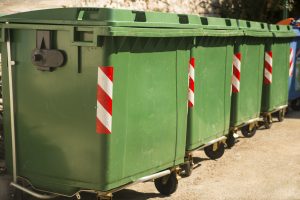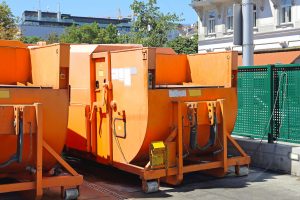by CharlieB | Nov 21, 2016
 When you think of edge trim, you probably consider it to be harmless. That’s assuming, of course, that you give it any thought at all. In fact, some of you may be wondering: what do I even mean when I say edge trim? I mean the plastic remains of a product after it has been used. Edge trim can be a real problem for the manufacturing industry. It may look like it is easy to dispose of, worry free. But edge trim can actually be costing you money in ways that you don’t realize. KenBay believes in proper waste disposal, and too often manufacturing plants mishandle the disposal of edge trim. If you want to learn more, then read on.
When you think of edge trim, you probably consider it to be harmless. That’s assuming, of course, that you give it any thought at all. In fact, some of you may be wondering: what do I even mean when I say edge trim? I mean the plastic remains of a product after it has been used. Edge trim can be a real problem for the manufacturing industry. It may look like it is easy to dispose of, worry free. But edge trim can actually be costing you money in ways that you don’t realize. KenBay believes in proper waste disposal, and too often manufacturing plants mishandle the disposal of edge trim. If you want to learn more, then read on.
Edge trim can Halt Production.
At its worst, a jam from edge trim can stop your entire production line dead. The plastic gets stuck in the machines and nothing else can get through. Manufacturing plants are like an elaborate cogwork mechanism: they require every part to be functional in order to operate. When one part stops, the whole thing has to shut down and wait for it to be up and running again. This means wasted time!
It Requires Human Labor to Address the Jam.
Once the jam has begun, it takes money and manpower to fix. You may need to have someone from the machine’s original manufacturer come out and take a look. Do you trust an inexperienced worker to look at your machinery? Do they know how to take the machine apart and put it back together exactly as it was? Paying for someone to come and fix your problem (which is already costing you money by halting your production) can add additional expenses. Yes you get the production line back up and running, but how much money have you lost from paying for the expert on top of the lack of production?
A More Subtle Form of Financial Loss.
The people in charge of manufacturing plants know how devastating a full jam can be. As a result, companies don’t run their machines at full capacity for fear of jams. The machines run slower, which means less product is produced, which means less product to sell and fewer finances. Who knew something as seemingly inconsequential as Edge Trim could have such a widespread impact!
KenBay believes that edge trim shouldn’t have a stranglehold over your production. In our opinion, it’s better to dispose of the edge trim right at the source of the waste. We have actually spoken about this before! Our solution: place a RotoPac at the source of edge trim and remove it from the equation entirely. By eliminating the edge trim, you can run your machines at full speed. You eliminate the risk of halts in production. Finally, you reduce headcount because you don’t need to pay someone to unjam your assembly line! A simple solution ends up saving you a lot of time and money, and those savings definitely add up over time. If you are interested in trying one of KenBay’s portable RotoPacs for your plant, visit KenBay’s website where you can try it before you buy it.
by CharlieB | Nov 13, 2016
 KenBay is a company committed to proper waste management and to reducing disposable waste whenever possible. We encourage other organizations to do the same. One great way you can work towards a goal of zero waste is through examining your Material Flow. A Material Flow is like a map that shows the journey that materials make from the time that the materials enter the manufacturing facility to where they eventually end up. Some view it as an “essential” component to handling waste properly. You have more control over not only what is coming out of your plant, but also what you might bring in. Overall, evaluating your material flow is a great way to waste less and mine the most value out of your materials. Here are 4 ways examining your Material Flow can improve your overall efficiency.
KenBay is a company committed to proper waste management and to reducing disposable waste whenever possible. We encourage other organizations to do the same. One great way you can work towards a goal of zero waste is through examining your Material Flow. A Material Flow is like a map that shows the journey that materials make from the time that the materials enter the manufacturing facility to where they eventually end up. Some view it as an “essential” component to handling waste properly. You have more control over not only what is coming out of your plant, but also what you might bring in. Overall, evaluating your material flow is a great way to waste less and mine the most value out of your materials. Here are 4 ways examining your Material Flow can improve your overall efficiency.
Ensure That No Material is Accidentally Wasted.
The biggest benefit of material flow is that you can see exactly what is happening to all the materials you are using. This will help reduce unnecessary waste for your plant. If you discover that certain materials are being unnecessarily discarded, you can implement steps to prevent that. Likewise, you can help keep the necessary materials going right where they need to go. In that same vein . . .
Discover New Ways to Incorporate Otherwise Discarded Materials.
What this means is that examining your material flow allows you the opportunity to get creative with your recycling. As they say, “necessity is the mother of invention”! If you discover that you have excess waste of a certain material, perhaps there is a way to incorporate it into your processes. If you are using the resources you already have instead of having to purchase more, that’s improving efficiency.
A Material Flow Helps You to Re-Examine Resource Requirements.
A big hurdle for healthy efficiency is energy expenditure. Wasted energy is an incredible burden both on labor and finances. Examining your material flow can assist you in determining where cuts in energy expenditure can be made. Does the cooling or heating system need to be operating during certain seasons? Could there be a switch to a more energy efficient source of power, such as LED bulbs? Water management too is a big bonus here. If you find you can cut back on water usage in certain areas, do it! Water is a natural resource that should rightly be preserved and conserved when you can.
Develop a Strategy, Get Everyone Onboard
A big step for efficient processing is making sure everyone on your team understands what the goal is. There is no point in trying to save time and money if nobody in your program understands what to do. Using Material Flow provides a graphic visual representation that is easier for some people to understand. For many, a visual representation of the data helps in learning and understanding it.
If you are committed to zero waste for your facility, KenBay is a great resource for improving your waste management. We offer portable, efficient compactors that can be used right at the source of the waste, saving your workers time and reducing potential hazards. If you would like to know more, visit KenBay’s website, where you can take advantage of our offer to try it before you buy it. And remember: whether it’s through the right compactors or through your Material Flow, stay on top of what you are putting out into the world.
by CharlieB | Nov 4, 2016

We here at KenBay believe in 100 percent zero waste when it comes to waste management. That includes how wastewater is handled. Dewatering is a process which removes liquid sludge from solid waste. This allows the water to be treated, recycled, and reused. (If you would like a more in-depth explanation about how dewatering works, this website has an excellent summary.)
Not everyone considers dewatering to be a viable option. Many factories and plants worry that the costs of labor, equipment, and maintenance outweigh any potential benefits of dewatering. Some simply do not consider the environmental impact. Many of these corporations choose instead to store their wastewater in holding ponds. Unfortunately, holding ponds are far from an ideal solution. Ultimately, there is a financial cost for dewatering, but the benefits are absolutely worth it. Dewatering helps the environment, the local area, and you!
Dewatering Less of an Impact on the Environment
Let’s start with the most basic benefit: your responsible handling of wastewater will be better for the environment. You will be helping to recycle one of our planet’s natural resources. You can actually use that recycled water for whatever you need to. Others can use it as well! You are not the only production facility that needs to use clean water. If others have access to it, then their productivity increases. Yours increases as well! And better productivity means a better local economy.
Dewatering Makes Your Waste Easier to Manage.
Extracting water means your waste weighs less. Less weight makes the waste easier to transport. Transport where, you ask? Many of you probably assumed a landfill. But KenBay is committed to finding new ways to utilizing waste without resorting to landfills. We prefer turning waste into clean energy. And guess what? Dewatering also makes your waste easier to incinerate.
Ultimately, You are Paying a Cost Anyway.
Too much water in soil can actually be a bad thing. When left for too long, still water can corrode the foundations of buildings. The threat of corrosion is worse the older a building is! If you find yourself in this situation, you will need to pay the cost of repairs. Additionally, as noted above, untreated sludge water will costs more to store and transport, because of its heavier weight.
Finally, if you are found responsible for any environmental hazard, you will ultimately have to pay to help fix it. Not to mention, the cost PR to fix your facility’s damaged reputation. Ultimately, if you are going to pay a cost, why not make the choice that is better for our planet and your local area? Who knows, your sterling environmentally friendly reputation may actually drum up more business than before!
We hope you see the advantages of switching over to dewatering. You may be paying for it now, but ultimately the benefits far outweigh any costs. You will provide a great service for your local community, the planet, and ultimately yourself. If you are interested in other ways you can help properly manage waste, check out KenBay’s website. We offer convenient on-site compactors that make managing waste easier. You can request a free 14 day trial offer!
by CharlieB | Oct 28, 2016

They say that necessity is the mother of invention. Every great, long-lasting improvement in technology came about because there was a need for it. We needed faster ways of transportation, so the car was invented. Drivers couldn’t see in the rain, so windshield wipers were devised. All throughout history are examples of ingenuity rising up to solve a problem. Well, one modern day problem for plant workers is how to properly get rid of waste like label matrix trim. It needs to be disposed of, and there are a many machines built just for that purpose. But trim removal systems can occasionally jam if running too quickly, and clogged machines mean wasted time and money. Plant personnel have gotten very creative when it comes to dealing with label matrix disposal. Everything from shredding to actually devising ways to use it in the machine itself. We here at KenBay have a better idea: don’t deal with it at all! Simply throw the label matrix directly into a continuous compactor at the source of the waste. Just bag it and dump it!
Why a Continuous Compactor?
You’re probably familiar with a traditional trash compactor. They’re large, they smell bad, and they are normally triggered by opening and closing the door three times. If your plant is already using one, why is a continuous compactor better?
For one thing, a continuous compactor never needs to be manually switched on. It’s right there in the name, continuous. It never shuts off on its own! A constantly rotating arm keep pressing down whatever you throw into it into neat and tidy and stackable cubes. The shape of these cubes is another great thing about continuous compactors — you’re never paying to haul around any unnecessary air when you’re getting rid of your waste. Just stack the cubes up and fill more space on the junk hauler!
Another issue is safety. We mentioned that traditional compactors are big, right? Often they’re so large that they’re immovable without additional machinery. Once you set them down, they’re not going anywhere. What does this mean for you and your employees? It means that whenever you have something like a label matrix that you need to trash, you need to leave your station and move there physically. I don’t need to tell you the risk of walking around an area with heavy active machinery! Smaller continuous compactors can be placed right at the worksite, so you can just toss the label matrix trim in when you need to and continue on with the work. In short, it helps to reduce unnecessary risk.
KenBay Helps You Manage Label Matrix Disposal
KenBay has a wide variety of inexpensive continuous compactors that are portable and easy to handle. Because they have a small footprint, it is easy to have multiple compactors at key waste disposal sites. Our line of products not only offer a safer solution to waste disposal, they are efficient as well. You won’t squander unnecessary time disposing of your waste, and you won’t pay extra money to haul air to the landfill. If you are interested in having a continuous compactor for your plant, contact us to try it before you buy it. Discover the difference the right compactor can make!
 When you think of edge trim, you probably consider it to be harmless. That’s assuming, of course, that you give it any thought at all. In fact, some of you may be wondering: what do I even mean when I say edge trim? I mean the plastic remains of a product after it has been used. Edge trim can be a real problem for the manufacturing industry. It may look like it is easy to dispose of, worry free. But edge trim can actually be costing you money in ways that you don’t realize. KenBay believes in proper waste disposal, and too often manufacturing plants mishandle the disposal of edge trim. If you want to learn more, then read on.
When you think of edge trim, you probably consider it to be harmless. That’s assuming, of course, that you give it any thought at all. In fact, some of you may be wondering: what do I even mean when I say edge trim? I mean the plastic remains of a product after it has been used. Edge trim can be a real problem for the manufacturing industry. It may look like it is easy to dispose of, worry free. But edge trim can actually be costing you money in ways that you don’t realize. KenBay believes in proper waste disposal, and too often manufacturing plants mishandle the disposal of edge trim. If you want to learn more, then read on. 

 KenBay
KenBay

